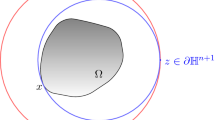Abstract
The inclination or \(\lambda \)-lemma is a fundamental tool in finite dimensional hyperbolic dynamics. In contrast to finite dimension, we consider the forward semi-flow on the loop space of a closed Riemannian manifold \(M\) provided by the heat flow. The main result is a backward \(\lambda \)-lemma for the heat flow near a hyperbolic fixed point \(x\). There are the following novelties. Firstly, infinite versus finite dimension. Secondly, semi-flow versus flow. Thirdly, suitable adaption provides a new proof in the finite dimensional case. Fourthly and a priori most surprisingly, our \(\lambda \)-lemma moves the given disk transversal to the unstable manifold backward in time, although there is no backward flow. As a first application we propose a new method to calculate the Conley homotopy index of \(x\).






Similar content being viewed by others
Notes
Note that the difference lies in \(X^-\), hence in \(C^\infty \). Therefore it makes sense to take the \(C^1\) norm.
Hence \(f\circ \xi :(0,T]\rightarrow Y\) is continuous and, by the Lipschitz Lemma 1, bounded.
Otherwise, choose \(\rho _0>0\) smaller. This leads to a smaller \({\varepsilon }\) in Hypothesis 1 (a). Condition (18) is used in step 4 and in the proof of Theorem 2, both concerning \(C^1\).
The definition of \(T_1\) ensures in step 2 the second of the two endpoint conditions (21).
The conditions on \(T_2\) will be used in step 6, in particular in (39).
The argument relies on the right boundary of the \(t\)-interval running to \(-\infty \), as \(T\rightarrow \infty \). Therefore the right boundary of \(II\) needs to be strictly smaller than \(T\), but at the same time be element of \([0,T]\) whichever \(T\) we pick. Thus any \(\alpha T\) with \(0<\alpha <1\) is a good choice.
Exponential decay is achieved, if the left boundary of \(\textit{III}\) is of the form \(\alpha T\) with \(\alpha >\frac{1}{2}\).
Here and throughout \(\left( \int _a^b +\int _c^d\right) f\) abbreviates \(\int _a^b f+\int _c^d f\).
References
Abbondandolo, A., Majer, P.: Lectures on the Morse complex for infinite dimensional manifolds, in Morse theoretic methods in nonlinear analysis and in symplectic topology. In: Biran, P., Cornea, O., Lalonde, F. (eds.) NATO Science Series II: Mathematics, Physics and Chemistry, pp. 1–74. Springer, New York (2006)
Chow, S.-N., Hale, J.K.: Methods of bifurcation theory. Grundlehren Math. Wissensch. 251 (1996) (Springer, 1982, corrected second printing)
Chow, S.-N., Lin, X.-B., Lu, K.: Smooth invariant foliations in infinite dimensional spaces. J. Differ. Equ. 94, 266–291 (1991)
Conley, C.C.: Isolated invariant sets and the Morse index. In: CBMS Regional Conference Series in Mathematics, vol. 38. American Mathematical Society, Providence (1978)
Grobman, D.: Homeomorphisms of systems of differential equations. Dokl. Akad. Nauk. SSSR 128, 880–881 (1959)
Hadamard, J.: Sur l’iteration et les solutions asymptotiques des équations differentielles. Bull. Soc. Math. Fr. 29, 224–228 (1901)
Hartman, P.: A lemma in the theory of structural stability of differential equations. Proc. Am. Math. Soc. 11, 610–620 (1960)
Henry, D.: Geometric theory of semilinear parabolic equations. In: Lecture Notes in Mathematics, vol. 840. Springer-Verlag, Berlin (1993) (1981, third printing)
Lorenzi, L., Lunardi, A., Metafune, G., Pallara, D.: Analytic semigroups and reaction–diffusion problems. Internet sem 2004–2005. http://www.math.unipr.it/~lunardi/LectureNotes/I-Sem2005.pdf (2005). Accessed 10 Oct 2011
Palis, J.: On Morse–Smale Diffeomorphisms. Ph.D. thesis, UC Berkeley. http://www.math.sunysb.edu/~joa/PUBLICATIONS/ (1967)
Palis, J.: On Morse–Smale dynamical systems. Topology 8, 385–404 (1968)
Palis Jr, J., de Melo, W.: Geometric Theory of Dynamical Systems. Springer-Verlag, New York (1982)
Perron, O.: Über die Stabilität und asymptotisches Verhalten der Integrale von Differential gleichungssystemen. Math. Z. 29, 129–160 (1928)
Reed, M., Simon, B.: Functional Analysis. Methods of modern mathematical physics I. Academic Press, London (1980)
Salamon, D.A.: Morse theory, the Conley index and Floer homology. Bull. LMS 22, 113–140 (1990)
Salamon, D.A., Weber, J.: Floer homology and the heat flow. GAFA 16, 1050–1138 (2006)
Weber, J.: The heat flow and the homology of the loop space. http://www.math.sunysb.edu/~joa/PUBLICATIONS/2010%20habilitation.pdf. HU, Berlin (2010). Accessed 19 Apr 2012
Weber, J.: Morse homology for the heat flow. Math. Z. 275(1), 1–54 (2013)
Weber, J.: The backward \(\lambda \)-lemma and Morse filtrations. In: Proceedings Nonlinear Differential Equations, 17–21 September 2012, João Pessoa, Brazil, pp. 1–9. http://arxiv.org/abs/1211.2180 (2012) (to appear in PNLDE). Accessed 16 Mar 2013
Weber, J.: Stable foliations and the homology of the loop space (2014) (in preparation)
Weber, J.: The Heat Flow and the Homology of the Loop Space (2014) (in preparation)
Acknowledgments
For hospitality I would like to thank Universität Bielefeld where foundations were laid. In this respect I am most grateful to Helmut Hofer for the right words in a difficult moment. Many thanks to André de Carvalho and Pedro Salomão for building the bridge to a new continent and, in particular, the excellent research conditions provided by IME USP and FAPESP. Last, not least, the paper would not exist without Dietmar Salamon teaching me for many years his way of solving complex problems. I owe him deeply.
Author information
Authors and Affiliations
Corresponding author
Additional information
Research supported by Universität Bielefeld and Fundação de Amparo à Pesquisa do Estado de São Paulo, FAPESP grants 2011/01830-1 and 2013/20912-4.




